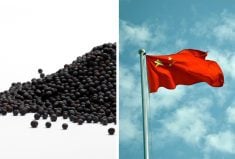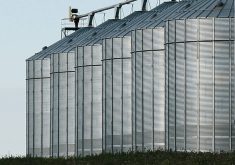COALDALE, Alta — Crop treated with plant growth regulators will not be accepted this year by Pioneer, Parrish & Heimbecker and Cargill.
Farmers at a June 11 plot visit here said they had received letters from the companies about the policy, put in place because the United States has not yet established maximum residue limits.
“This will get fixed, but it will take awhile,” said David Corry, technical sales representative for Engage Agro, which sells the Manipulator brand of growth regulator.
“I’m hoping for sooner than later.”

Corry said Viterra will accept crop treated with regulators, but it will require farmers to sign a declaration and it will segregate the grain so it can be sold domestically.
“That is one marketing option. The other options would be feed wheat … or seed that’s probably not destined for out of the country.”
Corry said the restrictions will give producers a chance to test the effectiveness of Manipulator and other plant growth regulators to see if they’re a good fit.
“They’re not targeted at the average producer,” he said. “They’re targeted at the fellows that are pushing their production, the guys that are at the top end. They’ve either got a lot of fertility or a lot of manure. They’re growing a rank crop that can lie down with wind or rain.”
Read Also

Canada and China discuss disputes over canola and EVs, says Ottawa
Senior Canadian and Chinese officials discussed bilateral trade disputes involving canola and electric vehicles on Friday, Ottawa said, but gave no indication of any immediate breakthrough.
Manipulator and another unnamed plant growth regulator are being tested in a broad plot project at Alberta Agriculture sites in the province.
Doon Pauly, Alberta Agriculture agronomy research specialist, said last year, the first year in a three-year project, the regulators reduced plant height in four of five locations but their effects on yield varied with moisture.
Pauly said regulators did not make much difference to plant height on shorter varieties. Taller varieties were shortened by five to eight centimetres.
“You could probably make that much difference just on your variety choice,” he said.
Agronomist Ross Mackenzie said he tested an earlier generation of crop growth regulators, specifically Cerone.
“It would shorten wheat and barley by about 10 cm,” said Mackenzie, formerly with Alberta Agriculture. “It was quite effective. However, we never had an increase in yield.”
He said application timing is critical for plant growth regulators. Older products, including Cerone and Cycocel, were usually applied at flag leaf to control height.
“They worked but didn’t necessarily reduce lodging and didn’t increase yield. There is a place for them, particularly for farmers that are growing barley for silage or a cereal crop on silage on heavily manured land where there’s greater tendency to lodge, or in higher rainfall areas where there’s lodging.”
Corry said plant growth regulators have been used in Europe for about 30 years, and Manipulator has been in use there for five or six years on crops including malting barley and milling wheat.
“Each farmer is going to have a different place to use this and a different way to use this and a different variety to use it on,” Corry said.
Contact barb.glen@producer.com















